日進市白山宮足王社の社殿がとても進化系でした。(愛知県名古屋市千種区姫池通 骨董買取 古美術風光舎)
2024.07.18
みなさまこんにちは、スタッフYでございます。
暑い日が続いておりますが、そうはいっても友人とどこか出かけてみようという話になりまして。先日気になっていました愛知県日進市の「白山宮」へ行って参りました。
なんだ、いつもの神社巡りなのか笑…と、思いきやそこはちょっと違うんですよ。
百聞は一見に如かず。とりあえず画像をみてみましょうか。
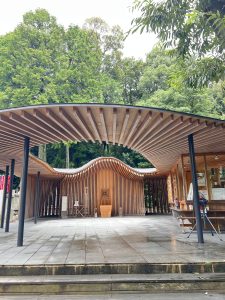
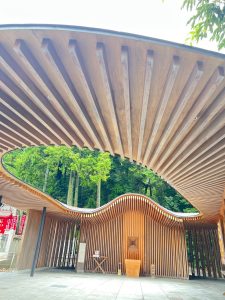
日進市白山宮の中にあります足王社であります。
白山宮の創立年代は不詳なのですが、境内に古墳があることから古い年代に求めることができ、加賀国白山のご分霊を勧請した近郷無双の古社であります。また、大永3年(1523)本郷城主、丹羽若狭守氏清(天文7年岩崎へ移城)が始めて祭祀を司ったとの記述も残っております。
近年では、夏の茅ノ輪祭をはじめ多くの祭礼に年間を通じ数万人の参拝者が訪れ、地元の方に愛される神社といったところでしょうか。
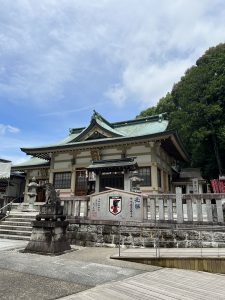
その白山宮の中にある足王社なのですが、ここには「痛みとり石」この石を手でさすり、痛みのある患部を撫でると痛みがとれたとの言い伝えがのこる伝説の石がまつられております。
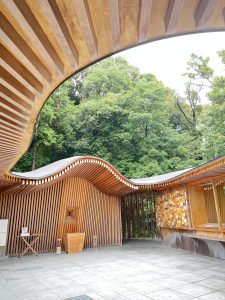
昔、飯田街道の裏街道と呼ばれた街道が日進市藤島町にあり、商人や旅人達が道中の足の安全を祈願する足名椎神をお祀りするほこらがあり、時代の流れと共に街道を行き交う人々も少なくなり、 街道隣接(藤島町大根)の山本邸に祀られていたものを終戦前後に当宮に勧請したのが起源とされるようになり、「足腰の神様」として有名になりました。
こちらの社殿の裏側、足王社の本殿内部の中央の神様の真下に「痛みとり石」は鎮座しておりますが、足腰の神様ということで「サッカー神社」とも呼ばれるようになり、日本代表のエンブレムがはいった御守、絵馬も授与され全国よりサポーターも参拝されているそうです。
それにしてもこの社殿は斬新ですね。社殿の屋根と一体化した回廊がうねうねと波うち、その空間中から社殿の奥の緑と清々しい風を感じ取れます。2017年に建造された社殿ですが設計の観点から読み取りますと…。
社殿の基本となる軸は南北に取り、参拝者がたどる経路は一方的な直線ではなく、多様で回遊的なものとています。社は細い木を組み合わせてつくられ、木の隙間から漏れる光や杜からの風を感じながら誘われ礼拝するようになっています。御神体の背後に光と木の柔らかな曲線に満たされた「洞の参道」に歩み入り、痛みとり石に触れ、帰途につくとき、杜と一体であることを実感できることを意図して設計されているそうです。
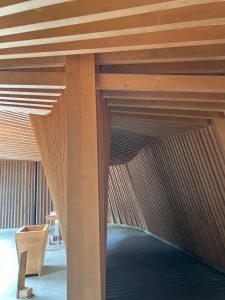
御神体の背後には光と木の柔らかな曲線に満たされた「洞の参道」があるのですが、そこに歩み入り「痛みとり石」に触れ(現在は手で触れてることはできません)帰途につくと、杜と一体であることを実感しながら通り抜けます。この社殿は遠くからただ拝むのでなく、杜の一部として神様を身近な存在の触れまた歩み出すような一連のかかわりを願ってこのような様式になっているのですが、まずは設計の意図など知らない状態で参拝をいたしました。
そして、後からその設計の意図を知りますと、なるほど。そのとおりでして、知らぬ間に参拝をして「洞の参道」にて「痛みとり石」に触れ(実際には触れていませんが)、より身近に、そして流れるような一連の参拝でありました。そして、拝殿から遠ざかったとしても、その印象的な景色がいつまでも脳裏に残ります。また、斬新な意匠ではあるのですがすっかり社に馴染んでいることにも気づきます。
ところで、神社の建築様式も神明造、大社造などなどありますが、その建築様式が必ず決まったものでなくてもよいとことにも驚いたのですが、ありなんですね。
とても斬新な足王社ですがその設計の意図がわかりますと、神様を大切に祀り心地よく参拝してもらいたい気持ちはどんな社殿においても同じ気持ちなのだということもわかりました。
そんな斬新な社殿にて足腰の健康を祈願し、清々しい気持ちと共に白山宮足王社を後に致しました。
それではごきげんよう。
Hello everyone, this is Staff Y.
It has been a hot day, but even so, my friends and I decided to go out somewhere. The other day, I went to “Hakusan Shrine” in Nisshin City, Aichi Prefecture, which I had been curious about.
What a surprise…it was just the usual shrine tour…but it was a little different.
Seeing is believing. Let’s take a look at the pictures for now.
This is Ashio Shrine in Hakusan Shrine in Nisshin City.
The date of establishment of Hakusan Shrine is unknown, but the presence of an ancient burial mound in the shrine’s precincts suggests an early date. It is said that Ujikiyo Niwa Wakasa no Mamoru, the lord of Hongo Castle (moved to Iwasaki in 1523), first performed rituals at the shrine.
In recent years, the shrine has been visited by tens of thousands of worshippers throughout the year for many festivals, including the summer Kayanowa Festival.
The Ashio Shrine is located in the Hakusan Shrine, where a legendary stone is enshrined that if one rubs the stone with one’s hand and caresses the affected part, the pain will be gone.
In the old days, there was a road called “Ura-Kaido” in Fujishima-cho, Nisshin City, where merchants and travelers prayed for the safety of their feet along the way. It is said that the shrine became famous as the “God of Legs and Backs.
The “pain relief stone” is located behind this shrine pavilion, directly under the central deity in the main hall of Ashio Shrine.
The shrine pavilion is very innovative. The corridor, which is integrated with the roof of the shrine building, undulates in waves, and from within this space, one can feel the greenery behind the shrine building and the refreshing breeze.
The basic axis of the shrine is north-south, and the path taken by visitors is not a one-way straight line, but a diverse and circuitous one. The shrine is made of a combination of thin trees, and visitors are invited to worship while feeling the light leaking through the gaps between the trees and the breeze from the forest. The shrine was designed with the intention that visitors will feel at one with the forest when they walk into the “Cave Approach,” filled with light and the soft curves of the trees behind the sacred body, touch the pain-taking stones, and return home.
Behind the sacred body is a “cave path” filled with light and soft curves of wood, and when you enter the path, touch the “pain-relieving stone” (currently not accessible by hand), and return home, you will feel at one with the forest. This shrine pavilion is designed in such a way that you do not just worship from a distance, but rather, as a part of the forest, you touch God as if you are close to Him, and you hope that you will be able to step forward to experience His presence again.
I first visited the shrine without knowing the intent of the design, and when I later learned the intent of the design, I realized that it was exactly as I had expected. I was right. I visited the shrine without realizing it and touched the “pain-relieving stone” on the “cave path” (although I did not actually touch it), which made me feel closer to the shrine and made my visit to the shrine more fluid. And even if you move away from the worship hall, the view will forever remain as an impression.
I was also surprised to see that the architectural style of the shrine, whether Shinmei-zukuri or Taisha-zukuri, does not always have to be a specific one.
The Ashio Shrine is very innovative, but I am sure that the desire to worship the gods with care and comfort is the same in any shrine building. Today, I prayed for the health of my legs and feet, and left Hakusangu Ashio Shrine with a fresh and innovative feeling.
I wish you all the best.
*******************
ご実家の整理やお片付けなどをされている方のご相談などが多くございます。
お片付けなどくれぐれもご無理のないようになさってくださいませ。
風光舎では古美術品や骨董品の他にも絵画や宝石、趣味のお品など様々なジャンルのものを買受しております。
お片付けをされていて、こういうものでもいいのかしらと迷われているものでも、どうぞお気軽にご相談下さいませ。
また風光舎は、出張買取も強化しております。ご近所はもちろん、愛知県内、岐阜県、三重県その他の県へも出張いたします。
まずは、お電話お待ちしております。
愛知県名古屋市千種区姫池通
骨董 買取【古美術 風光舎 名古屋店】
TEL052(734)8444
10:00-18:00 OPEN
#出張買取#骨董#古美術#骨董品#絵画#版画#茶道具#刀剣#彫刻

